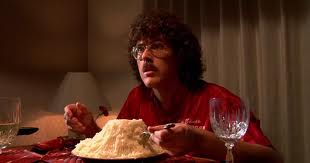Ulrich Seidl’s Paradise trilogy, a film series featured at the Walker this week,
takes loosely related characters, all women on a kind of “vacation,”
and wonders about the paradox of escape. What will strike viewers first
is Seidl’s upfront presentation of bodies that we’re not accustomed to
seeing on screen. In the social and spiritual critique the filmmaker
stirs into the film there’s the problem of the body, with all of its
insatiable urges that weigh people down and determine vectors of action —
or docility and inaction. Is pleasure so rampant in a permissive and
secular society? Escape – through the film’s three chapters of “Love,”
“Faith,” and “Hope” – is tied to an evasion from the tyrannical confines
of the body, itself the victim of the socially determined shackles of
defined “beauty.” There’s a weird brand of contemporary gnosticism – if
it can be technically called “gnosticism” – where the dual worlds of
flesh and spirit, with the material world being shunned for more
transcendental matters, have shifted to this other Platonic cove of
Ideal Forms undulating in the infoculture of Reality TV and sizzling,
rampant advertising, the bodies preternaturally airbrushed and
reglossed. Contrary to that “gnosticism,” it’s full flesh and unabashed
“materialism,” but it’s of a hyperreal quality, and ultimately it’s an
intimation of a faraway paradise. These bodies might as well be Other,
or the transcendent world of “spirit.” The material world, meanwhile,
stares transfixed, perhaps blinded in emulation or a conscientiousness
haunting the staring onlookers.
Paradise is thenthe corpulent cousin to Harmony Korine’s Spring Breakers,
which also channels the hyperreal quality of an oversexed world,
morality taking the bus home before the nihilism of pleasure is
fulfilled in a group of white, beautiful and privileged characters
triumphantly killing darker-skinned (and thicker) ones, whose culture
the “spring breakers” have collectively appropriated — not as something
to be retained indefinitely, but to remembered as another fond memory,
cherished long after college course work is completed and a nice
bourgeois existence established.
But Spring Breakers is shot from the perspective of glorified beauty and celebrity, of Vanessa Hudgeons and Selena Gomez, whereas Paradise
has three related Austrian women, pale and bloated to varying degrees
as opposed to tanned and toned, interacting with environments as the
camera statically looks on from a distance (this isn’t to reflect a
preference for Paradise over Spring Breakers, as the latter, like Michael Bay’s recent Pain and Gain
— yes, I’m citing Bay in a column featuring Ulrich Seidl and Harmony
Korine — works on the audience’s unbridgeable disparity from the shining
spoils of celebrity). The stillness of the camera, in all three
chapters, gradually becomes more unsettled as temptation and carnal
hunger salivates and is uniformly disappointed for these women.'




